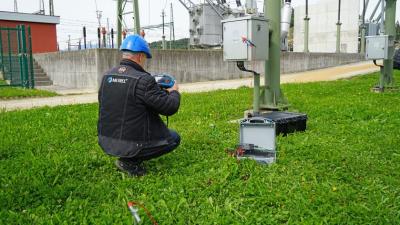Earthing resistance of transmission towers with the 25 kHz method
Power distribution

Most of today's grounding resistance measurement methods are based on the generally established FoP (Fall of Potential) method.
The FoP method is described in IEEE 81. It is based on a simplified model of rods and some additional preconditions:
- Current through both rods (E and H) is the same: IE = IH
- Uniform soil
- Hemispherical electrodes
The last two preconditions are fulfilled if the rules for minimum distances between the rods are fulfilled but the first requirement is not fulfilled as soon as the tested object has connections to remote earthing points. In such case the FoP method returns the earthing resistance value of the whole system, not only of the tested object.
Typical such objects are substations and pylons of the power transmission lines. Here the earthing resistance can be measured during the construction phase but once they are put into the operation, means the cable screens or the overhead grounding wire (OHGW) are connected, the use of classic FoP method is not possible.
Therefore, if we want to measure the grounding resistance of the power transmission tower in the operating state without disconnecting the OHGW, we have to use another measurement method.
One of the possible solution is the HF (25 kHz) method.
The basic idea of the HF method is to “virtually” disconnect the OHGW. Once this virtual disconnection is established, the classic FoP method can be used. This is described in IEEE 81-1983, EN 50522-2011 and in CIGRE document METHODS FOR MEASURING THE EARTH RESISTANCE OF TRANSMISSION TOWERS EQUIPPED WITH EARTH WIRES, Ch 6.1.2.
Application Notes
Measurements
How can this ‘virtual’ disconnection be established?
Usually the earth resistance measurements are done with the low frequency test signal in range from 45 to 300 Hz. The impedance of the OHGW is low and has more or less an ohmics character. The test current Igen is split into IE and IGW (usually IGW > IE) and therefore the FoP method returns false result.

But if the test signal has higher frequency, then the impedance of the OHGW increases and the IGW decreases. With typical frequency of 25 kHz this current is so low that it can be ignored.
IGW @25kHz << IE@25kHz
OHGW is ‘virtually’ disconnected and the first requirement
IE = Igen = IH
is fulfilled again and the standard FoP method can be used.

What are the advantages and limitations of this method?
The most pronounced advantage is simple and fast implementation in the field. The modern test instruments, like the Metrel MI 3290 Earth Analyser, are lightweight and battery powered. The needed test currents are low, in the range of some 100 mA, therefore only one or two auxiliary test probes H are needed. With the measurement cable length of up to 150 m in most cases the second and third requirements mentioned above are fulfilled.
The limitations are different:
- The most critical is the span between the transmission towers which has to be big enough to make the IGW is negligible. In specific conditions 250 m is the minimum, but usually the span length should be more than 300 m.
- Where the specific earth resistance is particularly high it might not be possible to inject high enough test current to achieve meaningful measurement. In that case also the RE is high, the relation IGW/RE decreases and the first requirement is not fulfilled again.
- Bigger earthing systems which require measurement cable length of more than 150 meters can’t be measured with HF method due to technical limitations.
- The mutual inductivity (a consequence of 25 kHz signal) between the measurement cables must be taken into consideration when performing a measurement with probes in a line where the cables are parallel. The cables must be kept as far apart from each other as practically achievable.

















